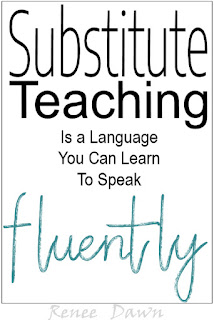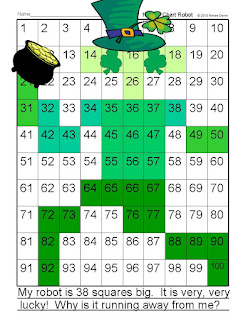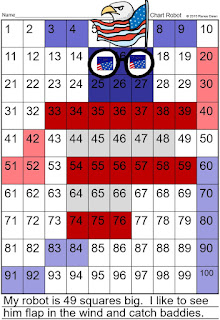Whether you’re a sub, or a regular teacher setting up a sub binder, you want tips and lots of 'em!
Ready? Here are my top 10 tips for a sub, AKA your Crash Course for Great Subbing:
1) Be safe. That means good behavior management and routines. You'll want to give clear, specific instructions for every action, starting from the moment your kids enter the room. You'll describe and demo each routine, let one kid try it, then a few kids, and finally the whole class.
Be sure to have a "stop" signal to bring the kids back to attention. You can say, "Give me five, four, three, two, one," with a hand raised and each finger lowered in turn; or say “Ready to Rock?” and have kids answer “And Roll!” Or you can briefly turn off the lights.
Safety goes double when you move through public spaces like the hall or cafeteria. Try walking backward at the head of the line. Trust me, it works. You don't want to be the sub with a cloud of wild children trailing you.
2) Make a
personal connection. Tell a story about
yourself, and ask kids to say something about themselves. Tell a joke. Don't think of yourself as a "sub!" You're "the teacher for the day," so try to make it enjoyable—even inspiring.
Find the regular teacher’s Sub Tub. Yes, they'll call it that, or a Sub Folder or wall chart. Look for a behavior guide, seating chart, and lineup list; or make your own, and call the kids by name. Remind them that their regular teacher will get a full report, and will be happy to hear they were wonderful.
Find the regular teacher’s Sub Tub. Yes, they'll call it that, or a Sub Folder or wall chart. Look for a behavior guide, seating chart, and lineup list; or make your own, and call the kids by name. Remind them that their regular teacher will get a full report, and will be happy to hear they were wonderful.
3) Teach! Follow the regular teacher’s lesson plans,
whenever possible. Give a mini-lesson
and instructions for work, then circulate to help kids stay on-task. Want to keep your sanity? Feel free to differentiate. For instance, allow one child to focus on artwork and another to write more words.
4)
Pack a tote. Bring a few fun books,
graphic organizers, and enough high-interest lessons to last a day, in case you
need them. You can celebrate a holiday or season with a book,
art, writing or simple craft. Also, pack sharp pencils, stickers, rewards, a 6" sponge ball for a quiet-pass game, baby wipes, a flash drive with PDF lesson files,
music and educational videos, a laptop with speakers; water and a snack for you. Yep, better to be over-prepared.
5)
Be organized. Ask yourself, “What absolutely must get
done?” Take attendance and collect notes for the teacher. Watch the clock; be on time for lunch, specialty classes, and
dismissal. Leave plenty of time for transitions. If you
find you have extra time, you can do a quick “bell ringer” activity, sing,
chant lines from the lesson, or do callbacks.
In Your Sub Kit
6) Be flexible. Extend or shorten a lesson, and take a brain break to calm—or
energize—the class. Let kids dance to a pop song, or breathe deeply and
massage their own faces.
7) Be
kind. Let the kids earn game-time, extra recess, or a quiet-ball
pass, with good behavior. It's easy. Just keep adding dots to a paper game-board and the kids'll perk right up. Every 20 dots they can win a brain break, like jumping in place twenty times. One of the best “rewards” is
to say, “Thank you for helping to make the day rock!”
These Reward
Tags are stylish, fun, easy, and effective behavior management
tools that kids will love!
8) Ask for
help. Ask the kids where to find things, or how the routines
go. Ask an organized child, or ask the class. Say, “Raise
your hand if you know…” Of course, ask another teacher if necessary.
9) Don’t raid
the shelves. Please...don't use up the class supplies,
crafts, pre-printed worksheets, or specialty notebooks unless the teacher
requests it. You may use plain copy paper if
there’s plenty of it, or bring your own.
10) We'll end with the Golden Rule: Respect the regular teacher’s room. It goes without saying, right? Leave it clean and tidy—and don’t leave open food containers, torn posters, or running electrical equipment. Give each child half a baby wipe to make the desktops gleam at the end of the day. Remember to leave a “While you were out” note, with a summary of the day and your contact info.
10) We'll end with the Golden Rule: Respect the regular teacher’s room. It goes without saying, right? Leave it clean and tidy—and don’t leave open food containers, torn posters, or running electrical equipment. Give each child half a baby wipe to make the desktops gleam at the end of the day. Remember to leave a “While you were out” note, with a summary of the day and your contact info.
Whether it's your first year subbing, or you simply want a
step-by-step guide for taking control of a classroom, I can help show you the
way.
NOT JUST FOR SUBS. Are you a regular teacher? This makes a great refresher course, or a sub binder for the days you're absent, with lessons that will last a full year.
I’m a New York City public school teacher with over twenty years’
experience. I’ve observed hundreds of subs and teachers in action, and
was a sub myself for three years prior to teaching full time. Now it’s my
pleasure to pass along all I’ve learned to you.
The Ultimate Guide for the Substitute Teacher includes hundreds of tips, teacher scripts, lessons, and printables that you can use all year.
The Ultimate Guide for the Substitute Teacher includes hundreds of tips, teacher scripts, lessons, and printables that you can use all year.
As
always, I'm wishing you all the best!

















































